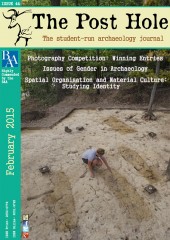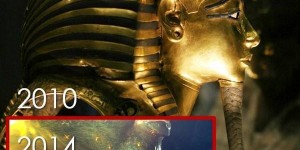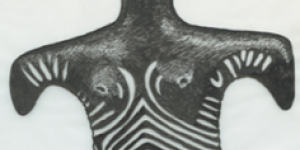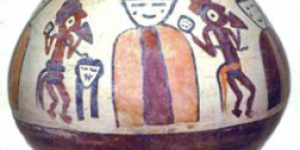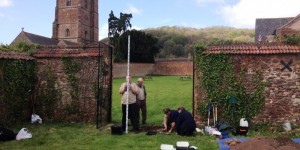It has been argued that we can scarcely do without the word identity today to describe an almost inviolable right to exist (Rowlands 2007, 60). It is no surprise therefore that identity, arguably associated with everything that comes under the umbrella of existing, is a difficult concept. Here the case will be made that identity is inherently too complex to be studied using any single method. Both material culture and spatial organisation used to study identity have strengths and weaknesses, with Johnson supporting the argument that the two used together in order to study identity where possible is the most appropriate option, stating that spatial ordering goes hand in hand with both the ordering of society and with material culture (2002, 69). I will contend that studying identity at the level of gender and class identity, for example, is useful but more refined definitions of identity are ultimately inaccessible. I will also explore some of the theoretical problems that come with studying identity through the archaeological record, exploring the idea that identity is largely irreducible in the majority of cases regardless of which method is employed in its study.
The English poet Donne thought that the individual was of little importance in the tide of human history, yet, conversely, Mill theorised that humans when brought together are not converted into another kind of substance (cited by Hodder and Hutson 2003, 7). Donne’s view is a good reflection of how studying identity in archaeology was once perceived within New Archaeology. The concept of the ‘individual’ was rejected for a long time, as New Archaeology preferred to look at what an artefact meant within the greater picture, and variability that might suggest individualism was overlooked (Hodder and Hutson 2003, 8), as such mimicking the opinion of Donne. However Mill’s view reflects the notion that, even when men are brought together under the same set of social conventions, their individual identity is not lost nor does it transform into something else readily accessible in the archaeological record. His outlook in particular shares similarities with arguments stressing the importance of agency in archaeology. Agency in the archaeological record has been considered unassailable through archaeological evidence, as it is both unpredictable and forceful of generalisation (Hodder and Hutson 2003, 7). Dant has reflected upon how archaeologists have long since acknowledged material culture as the evidence for distinct social cultures (Dant 1999, 2), and as such brings into question its applicability into looking for the individual. Overall, however, it is recognised that archaeology should not regress back to the approach favoured within the New Archaeology and completely ignore evidence reflecting individualism (Hodder and Hutson 2003, 7). The predominant issue regarding identity and its study through the archaeological record, is that identity is a term used in a variety of different ways (Diaz-Andreu et al. 2005, 1). Identity can be defined as the unique identifying characteristics of an individual (Diaz-Andreu et al. 2005, 1), as such heavily involving an individual’s personality. Identity defined in this manner is inaccessible within archaeology, as archaeologists are constrained by a lack of knowledge about specific individuals (Diaz-Andreu et al. 2005, 9). However, broader forms of identity, such as class, can be accessed through archaeology by applying methods using both spatial organisation and material culture.
Memories are motionless, yet their spatialisation is able to transform them into something more tangible and as such localising memory in time (Meskell 2003, 39). A similar thing can be said of identity. Spatial organisation enables a concept such as identity, otherwise an abstract concept and ephemeral in that identity is ever changing (Mattingley 2004, 11), to be grounded in something more concrete, something that physically exists, such as the urban fabric of a city. One example comes from Abu-Lughod, who argues that Muslim and Hindu quarters are distinguishable through the use of convoluted street patterns in Muslim lodgings (1987, 162). Therefore, she believes that Muslim identity can be discerned from a Hindu identity by looking at how space has been utilised. She also discusses the influence the Islamic religion has on the spatial organisation of residential quarters (Abu-Lughod 1987, 164). For example, buildings are laid out in such a way that women can see men, but not vice versa (Abi-Lughod 1987, 164). This is achieved through the use of bent entrances to create visual blind spots and make it impossible for buildings opposite one another to have their doors directly facing one another (Abu-Lughod 1987, 164). She argues, however, that this was the reality only for those wealthy enough to be able to afford to duplicate space in their homes and segregate men and women entirely (Abu-Lughod 1987, 164). The use of space in this scenario could indicate wealth and perhaps a high social status, but also the likelihood of religion being a significant contributor to the identities of the people occupying these types of spaces. Furthermore, and on a much larger scale, elite identity has alternatively been shown through the spatial organisation of an entire city, an example being the medieval Islamic city of Madinat al-Zahra. Here, the power of the caliphate was spatially represented, with the palace standing on the highest point of the site and constructed in tiers (Bennison 2007, 72). The administrative buildings were built on the second terrace, which, paired with the palace on the top terrace, formed a royal zone of limited and restricted access to the majority of the general public (Bennison 2007, 72). It is evident here how spatial organisation can be carefully employed to reveal the powerful and elite identity of one individual, something which Johnson has also studied via the use of space in medieval castles. He argues that guests will not know where in the castle is or is not accessible to them, for example, the chamber beyond the great hall at Tattershall Castle, which was only accessible in certain circumstances to the visitor (Johnson 2002, 80). Further supporting evidence comes from Gilchrist, who states that royal castles were mostly urban, built with the intention to dominate the town population (2009, 314). This highlights again how space can be manipulated within the landscape to express wealth and powerful identity of one individual over another.
As well as spatial organisation, material culture can be used to access aspects of identity. An example of material culture being used to study gender identity comes from Scandinavian style brooches. Brooches have been found in northern and eastern England, and their total number has now surpassed what was once thought to be the original overall total (Kershaw 2009, 296). As such, the presence of women in more significant numbers in the Danelaw than was once thought to be the case has become a favoured conclusion, and one that has been drawn from studying the material culture (Kershaw 2009, 296). Four hundred and eighty five brooches were studied from what was once the Danelaw, with more than half being of Scandinavian style (Kershaw 2009, 298). The high number of Scandinavian style brooches suggests that they were introduced to England via female settlers, who wore the brooches on their clothing (Kershaw 2009, 299). Brooches as grave goods can also be particularly helpful in determining the sex of skeletal remains. The remains of a woman and her new-born were discovered on the Island of Rousay in Orkney for example, her grave containing a characteristic Scandinavian oval bronze brooch, indicating strongly that she was a Norse woman (Jesch 1991, 9). Brooches of this style have been found in other burials too, indicating them as grave goods characteristic of Norse women and are therefore helpful when establishing gender identity, and arguably also useful in establishing an ethnic identity. It is evident, therefore, that from the discovery of brooches at Danelaw alone, three conclusions relating to identity can be drawn: the ratio of women to men in the Danelaw was higher than expected; these women can be identified as Scandinavian and the skeletal remains buried with brooches are likely to be female rather than male (although not always exclusively).
However both spatial organisation and material culture, as methods for studying identity, have their limitations. For example, it is only possible to study how space has been utilised if a house or city physically still exists to be studied, such as the famously preserved city of Pompeii. However, this is neither the norm nor the universal standard within archaeology.
Furthermore, despite Pompeii being a physical reality in the present (Laurence 2007, 1), the history of its excavation over more than two hundred years has been turbulent, with information having been destroyed, ignored and unreported (Wallace-Hadrill 1990, 150). This highlights how, even when there is potentially the best opportunity of being able to study spatial organisation and begin to try and access identities in the past, challenges are still likely to arise. Another difficulty in studying spatial organisation is that some cities are completely unrecoverable through archaeology. Eighth century Baghdad sits underneath modern day Baghdad, making excavation on a grand scale incredibly unlikely. Furthermore, issues can arise through an individual inadvertently creating the identities of other individuals through their use of spatial organisation. For example, Madinat al-Zahra showcases the elite identity of the Caliph living on the top terrace, and as such implies those that did not live on the top terrace or have access to the royal zone were of a low social status. The Caliph, by highlighting his class identity through the use of space, has gone on to impact everybody else in that setting. It is therefore paramount that generalisations which extend beyond just the one individual based on the spatial ordering are carefully considered, as the social status for many individuals may not have been a defining feature of their identity.
Similarly, the relationship between material culture and identity was once considered unproblematic (Diaz-Andreu et al. 2005, 2), a notion which has since been challenged. A key problem for archaeologists is understanding the journey of an artefact; how does it get from its place of manufacture to the place where it is eventually deposited? Investigating this through material culture is very difficult (Milwright 2010, 160). For example, one process is gift giving, a form of exchange in early Medieval Europe. Vestergaard highlights how material objects are useful in providing insight into trade connections and skills in handicraft (1991, 97). Using material culture to study identity creates a more complicated picture; gift giving was both a voluntary action and a social ‘must’ (Vestergaard 1991, 98). However, whilst gift giving is known to be a feature of the Norse world, it is no easy task to determine what, within an archaeological assemblage, may have been offered as a gift. This reflects the problem raised by Milwright. Another problem is that, although gifts may be perceived as being a reflection of the individual’s identity, integral to gift giving is the acceptance of the gift (Vestergaard 1991, 97). It is possible therefore that an individual may have been obliged as part of the institution of gift giving to accept a gift that they did not identify with, and had it not been for the custom of gift giving they would not have accepted or ever come into contact with it.
Another issue concerning material culture is that of a projected self-image (Cross 2002, 41). Medieval knights were typically depicted either baring swords or in prayer (Cross 2002, 42). It is possible that these expressions of identity were more an effort to conform to social conventions and values of the time, rather than being a true reflection of the individual’s identity. Further supporting evidence comes from the Luttrell Psalter, in which many of the images merge everyday activities with biblical references (Backhouse, 1989), highlighting how connections to Christianity and the church were particularly desirable (Cross 2002, 42), but not necessarily accurate.
The study of identities in the past, be it through spatial organisation or material culture, has significant difficulties that go beyond the challenges that arise from the specific method employed. Shennan points out the challenges of being able to get at the truth behind archaeology (1989, 2), this problem wholly derives from an inability to maintain objectivity. The interpretation of archaeological material will never fail to differ between archaeologists, as who we are affects how we perceive the world (Shennan 1989, 1). An archaeologist with a background interest in politics and an archaeologist with a background interest in economics, for instance, may make different interpretations of the same material (Shennan 1989, 2), aptly pulling the issue of objectivity into the concluding statement that anything beyond description is merely just guesswork (Shennan 1989, 2). Teamed, then, with the issue of identity in particular being a subjective concept and open to many different understandings (Tilley 2006, 7), it is clear why studying identity is laced with such intricate complexities. Hawkes argued that unaided inference from material remains to spiritual life is the hardest inference of all (Fig. 1), his point fundamentally being that subjective concepts, such as identity, are harder to access archaeologically (1954, 162). However, this does not mean to say the study of identity in archaeology should be abandoned, for some areas of identity have been made accessible, through both material culture and spatial organisation as highlighted in the case studies above. What should be kept in mind, however, is the limitations in what archaeology can offer.
It should also be noted that an individual’s identity is constantly evolving, and does not remain static (Mattingley 2004, 10). A key example of this is Regina from South Shields, commonly thought to be the archetype of a Roman lady, whose identity was unsurprisingly complex (Mattingley 2004, 11). She was first a slave, and later freed by marrying her owner (Mattingley 2004, 11), thus, reinforcing the fundamental understanding of identity; that it is constantly evolving. As such, through the archaeological record we will only ever see a brief snapshot of an individual, and must reflect that the interpretations drawn from archaeological evidence may not extend across or be applicable to the entirety of an individual’s life.
Also relevant is a recent study conducted by the BBC, a survey which has shed light on the complexity of people’s sense of identity. Its relevance comes from the potential that the findings in today’s societies and of today’s individuals may hold true for those who lived in the past; archaeologists are increasingly realising that today’s identities matter in how identities in the past are studied (Diaz-Andreu et al. 2005, 11). Diaz-Andrea also highlights the problems and limitations of focusing on the likes of religious or national identities (2005, 11). The majority of people within the survey considered their identity to be built up of their interests and leisure activities (Easton 2014), followed by their values and personal opinions (Easton 2014). What is noteworthy from these findings is that none are actually identities that we are born with (Easton 2014), such as nationality, gender, ethnicity or social class. Support which may highlight the applicability of such a survey to the study of identities in the archaeological record comes from Hadley, who discusses ethnic identity as not being innate, but instead the result of individuals or groups identifying with one another based on shared common interests (2002, 46). As well as this, it can be seen from Johnson that there is a general scepticism towards the idea that identity is given by some core feature, such as biological sex, and that there is now a stress on agency in the creation of identities (2010, 141) . However, the use of both spatial organisation and material culture to study identity has largely been concerned with individuals being pigeonholed and sorted into predetermined labels (Meskell 2007, 23), focusing on issues of identity such as class, ethnicity and gender. As such, we are focusing only on single elements which make up an individual’s identity (Meskell 2007, 23) and thus fail to access the fundamental aspects of what defines identity as a whole.
The potential danger of using the past to define identity should also be noted (Shennan 1989, 10). One key example is the work of Kossinna and his fixation on national identity. His Kulturkreis theory offered theoretical support for the expansionist policies of the Nazi regime (Arnold 1990, 464), resulting in land being declared as ancient German territory, even if only one artefact deemed Germanic was unearthed (Arnold 1990, 464). This was then used to give substance to the belief that the German people were of superior origin (Shennan 1989, 10) and could claim rights over land. This highlights clearly how studying identities in the past can result in frightening consequences. His work was to be seized upon by senior officers in the Third Reich such as Himmler (Jones 2002, 3) and Hodder has argued that few can now work without the shadow of misusing the past for nationalistic purposes during the Third Reich (1991, 197). Meskell argues further that it is the longevity of data in archaeology that enables inequalities to be produced, due to the tangible nature of material culture (2007, 24).
Ultimately, there may be some cases where categories such as ethnic, national and religious identity may suffer from the fact that these are identities given to an individual by the archaeologist; likely based on what material culture and spatial organisation can tell us, rather than the identity the individual would have given themselves. In many cases, this will probably never materialise in the archaeological record, if the construction of identities in the past was concerned with personal values, interests and opinions. Meskall succinctly highlights that we often “forget the subjective, inner world of the individual” (2007, 24), and that it is paramount that human agency and volition is not disregarded when dealing with the volatile nature of identity (Meskall 2007, 28). It is important, however, that studying identity within archaeology does not regress back to being overlooked and ignored but simply acknowledges that accessing identity, through whichever method, only has a limited chain of inference before we are left conjecturing about the finer and arguably more important, details of an individual’s identity.
References
- Abu-Lughod, J. L. (1987). The Islamic City - Historic Myth, Islamic Essence, and Contemporary Relevance. International Journal of Middle Eastern Studies. 19, 155-76.
- Arnold, B. (1990). The past as propaganda: totalitarian archaeology in Nazi Germany. Antiquity. 64(244), 464-478.
- Backhouse, J. (1989). The Lutrrell Psalter [Online]. The Luttrells. Last updated: 2001. Available at: http://theluttrells.homestead.com/LuttrellPsalter.html. Accessed on: 29 April 2014.
- Bennison, K. A. (2007). Power and the city in the Islamic West from the Umayyads to the Almohads. In A. K. Bennison and A. L. Gascoigne (Eds). Cities in the Pre-Modern Islamic World. Oxon: Routledge. 65-95.
- Cross, P. R. (2002). ‘Knighthood, heraldry and social exclusion in Edwardian England. In P. Cross and M. Keen (Eds). Heraldry, Pageantry and Social Display in Medieval England. Woodbridge: Boydell. 39-68.
- Dant, T. (1999). Material Culture In The Social World. [Online]. Available at: http://books.google.co.uk/books?hl=en&lr=&id=BUPlAAAAQBAJ&oi=fnd&pg=PP1&.... Accessed on: 17 April 2014.
- Diaz-Andreu, M., Lucy, S., Babic, S. and Edwards, D. (2005). The Archaeology of Identity. Approaches to Gender, Age, Status, Ethnicity and Religion. Oxon: Routledge.
- Easton, M. (2014). UK becoming more ‘local and global’ [Online]. BBC News. Last updated: 7 April 2014. Available at: http://www.bbc.co.uk/news/uk-26885743. Accessed on: 9 April 2014.
- Gilchrist, R. (2011). Landscapes of the Middle Ages, Churches, Castles and Monasteries. In J. Hunter and I. Ralston (Eds). The Archaeology of Britain. London: Routledge. 305-327
- Hadley, D. M. (2002). Viking and native: re–thinking identity in the Danelaw. Early Medieval Europe. 11(1), 45-70.
- Hawkes, C. (1954). Archaeological Theory and Method: Some Suggestions from the Old World. American Anthropologist. 56(2), 155-168.
- Hodder, I. (1991). Archaeological Theory in Europe: The Last Three Decades. London: Routledge.
- Hodder, I. and Hutson, S. (2003). Reading the Past: Current Approaches to Interpretation in Archaeology. Cambridge: Cambridge University Press.
- Jesch, J. (1991). Women in the Viking Age. Suffolk: The Boydell Press.
- Johnson, M. (2002). Behind the Castle Gate: from Medieval to Renaissance. London: Routledge.
- Johnson, M. (2010). Archaeological Theory: an introduction. Sussex: Wiley-Blackwell.
- Jones, S. (2002). The archaeology of ethnicity: constructing identities in the past and present. [Online]. Available at: http://books.google.co.uk/books?hl=en&lr=&id=K_SEAgAAQBAJ&oi=fnd&pg=PP1&.... Accessed on: 13 April 2014.
- Laurence, R. (2007). Roman Pompeii Space and Society. Oxen: Routledge.
- Meskell, L. (2003). Memory’s materiality. In R. M. van Dyke and S. E. Alcock (Eds). Archaeologies of memory. Oxford: Blackwell. 34-55.
- Meskell, L. (2007). Archaeologies of identity. In T. Insoll (Ed). The Archaeology of Identities: a reader. Oxon: Routledge. 23-44.
- Rowlands, M. (2007). Politics of identity in archaeology. In T. Insoll (Ed). The Archaeology of Identities: a reader. Oxen: Routledge. 60-71.
- Tilley, C. (2006). Introduction: Identity, Place, Landscape and Heritage. Journal of Material Culture. 11(1/2), 7-32.
- Vestergaard, E. (1991). Gift-giving, Hoarding, And Outdoings. In R. Samson (Ed). Social Approaches To Viking Studies. Glasgow: Cruithne Press. 97-104.
- Wallace-Hadrill, A. (1990). The social spread of Roman luxury: sampling Pompeii and Herculaneum. Papers of the British School at Rome. 58, 145-192.


